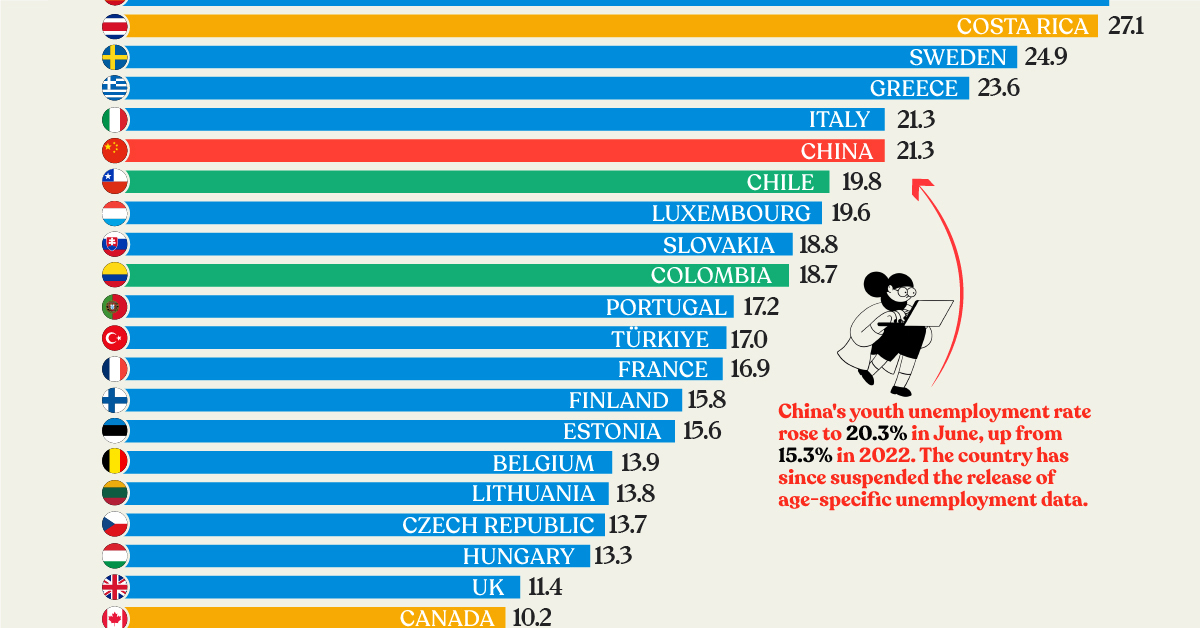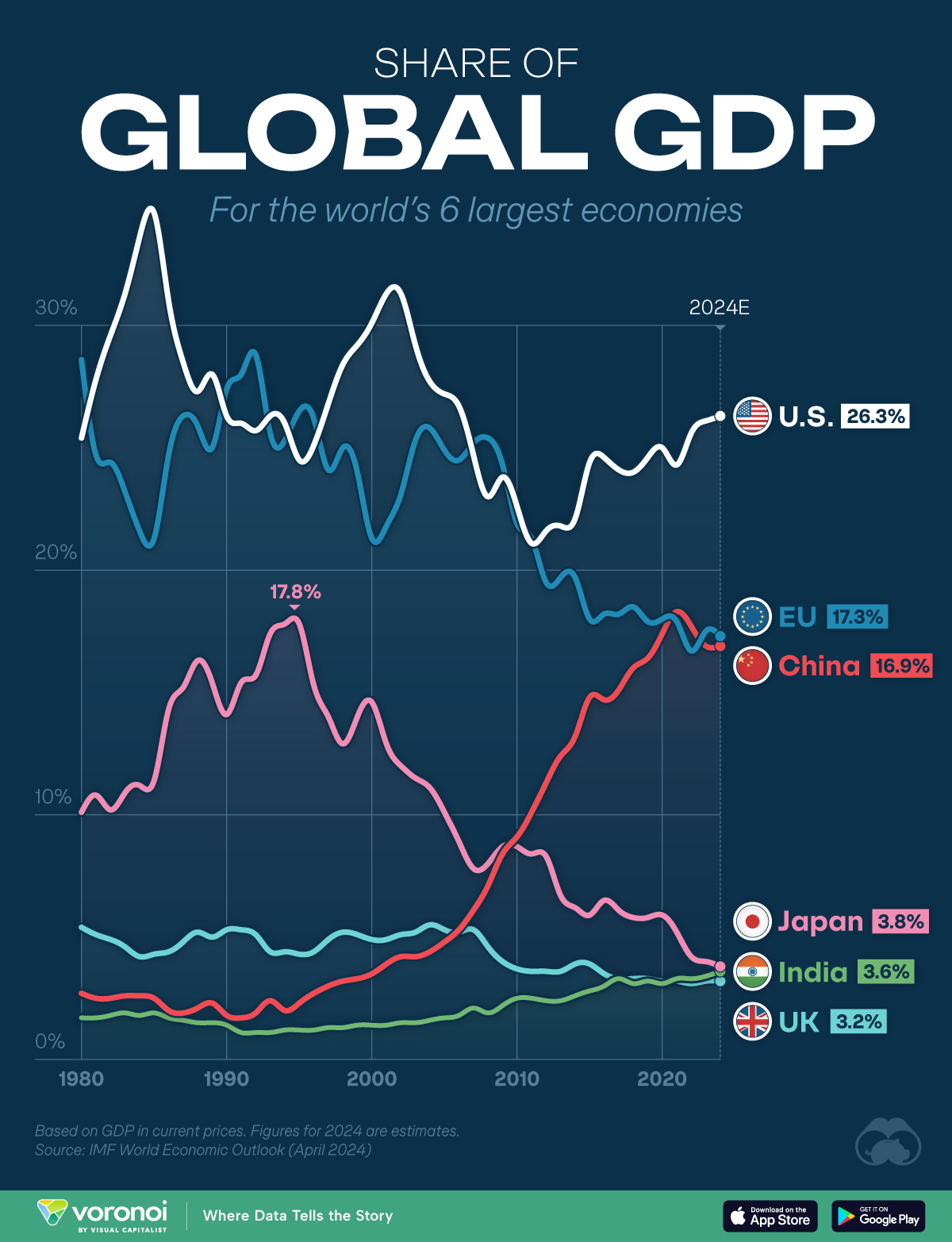China
Charted: Youth Unemployment in the OECD and China
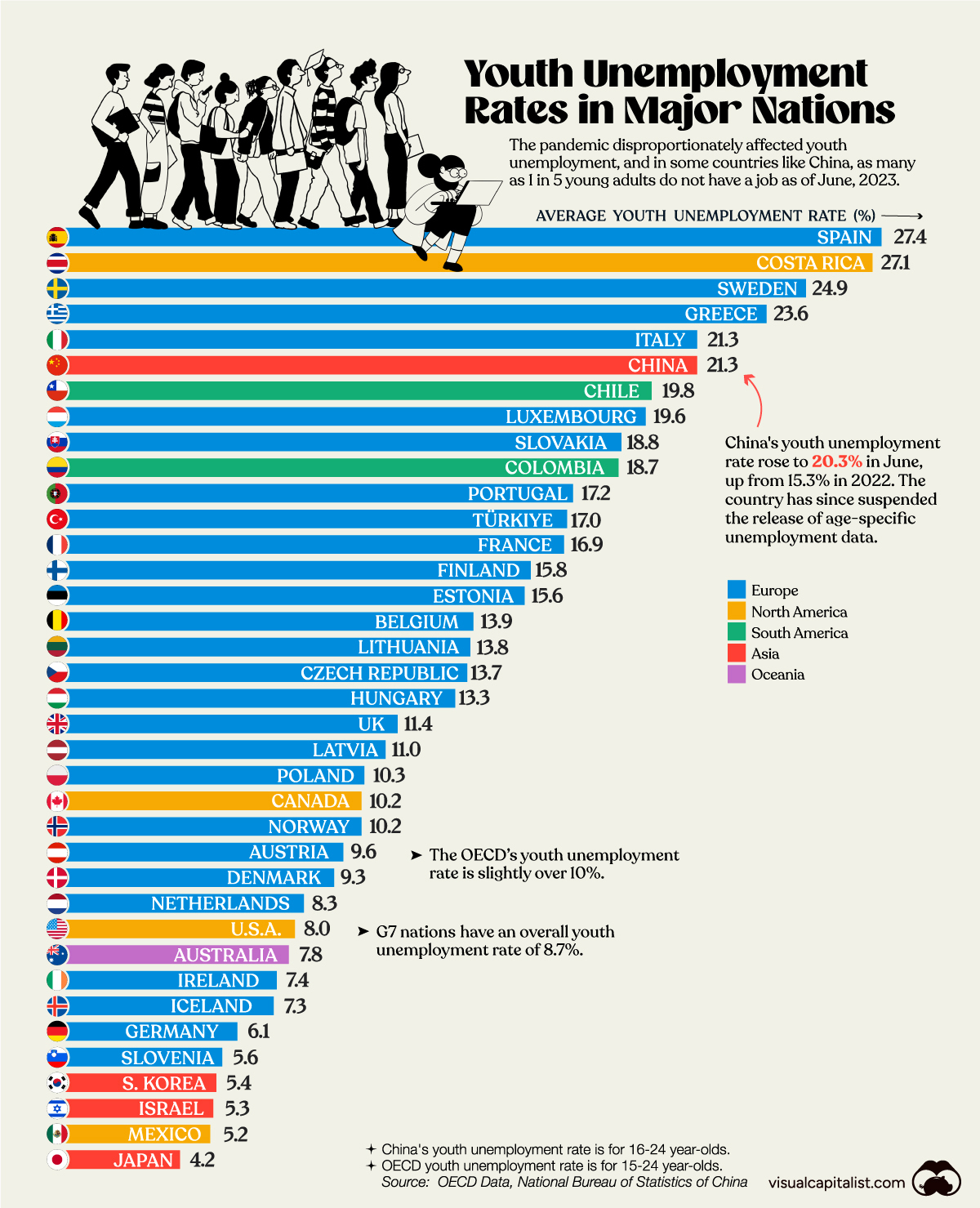
Charted: Youth Unemployment in the OECD and China
In nearly every country in the world, youth unemployment is much higher than general unemployment.
Unfortunately, the pandemic only exacerbated matters. During a crucial stretch of their early careers, young adults were locked out of entry-level jobs, destroying their ability to pick up work experience and potentially impacting their long-term earnings.
Now, nearly three years after COVID-19 first hit, young adults from some countries, like China, are struggling to find jobs. Using data from the OECD and the National Bureau of Statistics of China, we chart out the youth unemployment rate for 37 countries.
Ranked: Countries With the Highest Youth Unemployment
At the top of the list, Spain has the highest youth unemployment in the OECD, with nearly one in three young adults unable to find a job.
A mismatch between educational qualifications and the labor market has been cited as a significant reason for Spain’s lack of employed adults between the ages of 15–24.
Meanwhile, the country’s reliance on temporary contracts and dependence on seasonal sectors—like tourism—to generate jobs are some of the many reasons for its persistently high reported unemployment across demographic groups.
Listed below is the youth unemployment rate for all the OECD countries, and China, as of the second quarter of 2023.
| Rank | Country | Average Youth Unemployment Rate |
|---|---|---|
| 1 | 🇪🇸 Spain | 27.4% |
| 2 | 🇨🇷 Costa Rica | 27.1% |
| 3 | 🇸🇪 Sweden | 24.9% |
| 4 | 🇬🇷 Greece | 23.6% |
| 5 | 🇨🇳 China | 21.3% |
| 6 | 🇮🇹 Italy | 21.3% |
| 7 | 🇨🇱 Chile | 19.8% |
| 8 | 🇱🇺 Luxembourg | 19.6% |
| 9 | 🇸🇰 Slovakia | 18.8% |
| 10 | 🇨🇴 Colombia | 18.7% |
| 11 | 🇵🇹 Portugal | 17.2% |
| 12 | 🇹🇷 Türkiye | 17.0% |
| 13 | 🇫🇷 France | 16.9% |
| 14 | 🇫🇮 Finland | 15.8% |
| 15 | 🇪🇪 Estonia | 15.6% |
| 16 | 🇧🇪 Belgium | 13.9% |
| 17 | 🇱🇹 Lithuania | 13.8% |
| 18 | 🇨🇿 Czech Republic | 13.7% |
| 19 | 🇭🇺 Hungary | 13.3% |
| 20 | 🇬🇧 United Kingdom | 11.4% |
| 21 | 🇱🇻 Latvia | 11.0% |
| 22 | 🇵🇱 Poland | 10.3% |
| 23 | 🇳🇴 Norway | 10.2% |
| 24 | 🇨🇦 Canada | 10.2% |
| 25 | 🇦🇹 Austria | 9.6% |
| 26 | 🇩🇰 Denmark | 9.3% |
| 27 | 🇳🇱 Netherlands | 8.3% |
| 28 | 🇺🇸 United States | 8.0% |
| 29 | 🇦🇺 Australia | 7.8% |
| 30 | 🇮🇪 Ireland | 7.4% |
| 31 | 🇮🇸 Iceland | 7.3% |
| 32 | 🇩🇪 Germany | 6.1% |
| 33 | 🇸🇮 Slovenia | 5.6% |
| 34 | 🇰🇷 Korea | 5.4% |
| 35 | 🇮🇱 Israel | 5.3% |
| 36 | 🇲🇽 Mexico | 5.2% |
| 37 | 🇯🇵 Japan | 4.2% |
Announced in June, China’s youth unemployment rate has climbed to 21.3%, a meteoric rise since May 2018, when it was below 10%. The Chinese economy is in the midst of a slowdown and its steadily climbing youth unemployment prompted the government to suspend age-specific unemployment data for the near future.
On the other side of the spectrum, in Japan, only 4.2% of young adults are without a job. A key reason for this is Japan’s shrinking and aging population that’s made for a tight labor market.
Youth Unemployment: Men vs Women
In most OECD countries, it’s common to see young men experiencing a higher unemployment rate compared to young women.
This contrasts with the trend across all age groups in the OECD, where the unemployment rate is 6.3% for women and 6% for men.
We visualize the countries in the dataset with the biggest gaps in youth unemployment below.
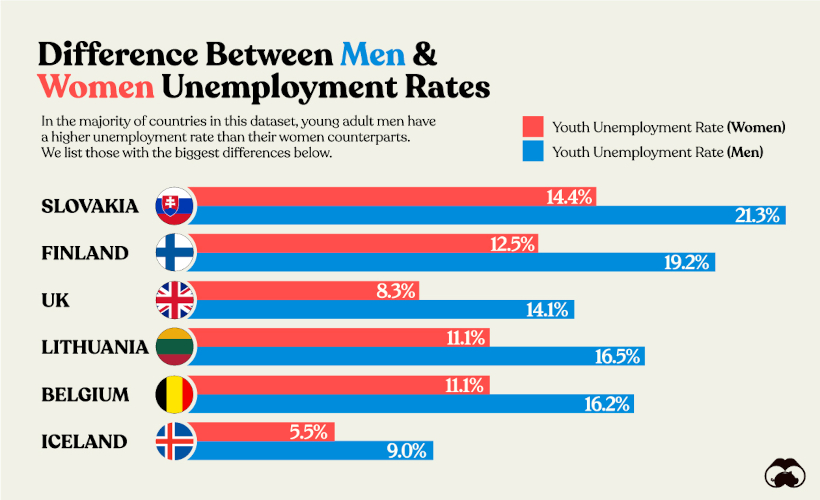
There is no singular reason that explains this common gap.
Across the OECD, more young women opt for tertiary education than young men, which may lead to better employment prospects. At the same time women are overrepresented in the health and social welfare sectors—both growing rapidly thanks to an aging population—that may make it easier for them to find jobs.
Why Does Tracking Youth Unemployment Matter?
Aside from being an indicator of general opportunities within a country, youth unemployment is a key metric to track, because it can be a bellwether for future economic prospects.
High rates of youth unemployment also correlate to brain drain within a country, as young adults move elsewhere to find better jobs.
Finally, large increases in unemployed youth have historically led to the potential of civil unrest, which makes it a politically-charged metric to identify and monitor for governments.
Where Does This Data Come From?
Sources: OECD Data and National Bureau of Statistics of China.
Note: China’s youth unemployment rate is for 16–24 year-olds. The OECD youth unemployment rate is for 15–24 year-olds.
United States
Ranked: The Top 6 Economies by Share of Global GDP (1980-2024)
Gain a unique perspective on the world’s economic order from this graphic showing % share of global GDP over time.
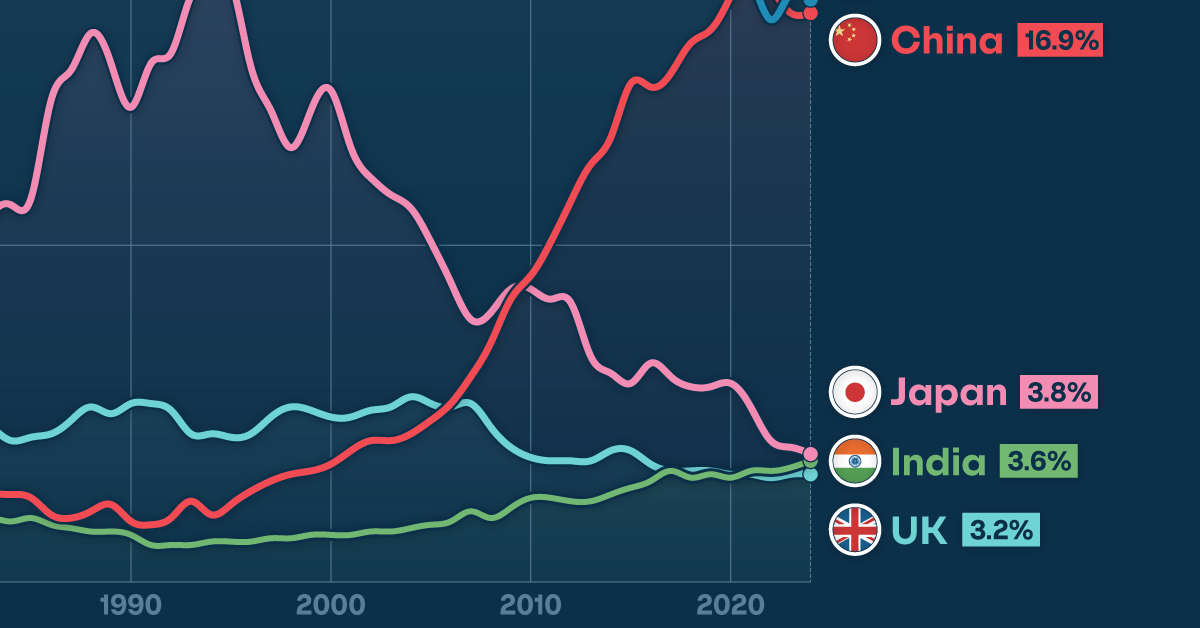
Top 6 Economies by Share of Global GDP (1980-2024)
This was originally posted on our Voronoi app. Download the app for free on iOS or Android and discover incredible data-driven charts from a variety of trusted sources.
Over time, the distribution of global GDP among the world’s largest economies has shifted dynamically, reflecting changes in economic policies, technological advancements, and demographic trends.
To see how this has played out in recent decades, we visualized the world’s top six economies by their share of global GDP from 1980 to 2024.
All figures were sourced from the IMF’s World Economic Outlook (April 2024 edition) and are based on using current prices.
Data and Highlights
The data we used to create this graphic can be found in the table below.
| Share of Global GDP (%) | U.S. | EU | China | Japan | UK | India |
|---|---|---|---|---|---|---|
| 1980 | 25.4% | 28.6% | 2.7% | 10.1% | 5.4% | 1.7% |
| 1981 | 27.8% | 24.7% | 2.5% | 10.8% | 5.1% | 1.7% |
| 1982 | 29.6% | 24.4% | 2.5% | 10.2% | 4.9% | 1.8% |
| 1983 | 31.3% | 23.2% | 2.6% | 10.9% | 4.6% | 1.9% |
| 1984 | 33.6% | 21.6% | 2.6% | 11.2% | 4.2% | 1.8% |
| 1985 | 34.6% | 21.3% | 2.5% | 11.4% | 4.3% | 1.9% |
| 1986 | 31.0% | 24.7% | 2.0% | 14.3% | 4.4% | 1.7% |
| 1987 | 28.5% | 26.3% | 1.9% | 15.2% | 4.8% | 1.6% |
| 1988 | 27.3% | 25.9% | 2.1% | 16.3% | 5.2% | 1.5% |
| 1989 | 28.0% | 25.0% | 2.3% | 15.4% | 5.0% | 1.5% |
| 1990 | 26.3% | 27.4% | 1.8% | 14.1% | 5.3% | 1.4% |
| 1991 | 26.0% | 28.0% | 1.7% | 15.4% | 5.3% | 1.1% |
| 1992 | 25.7% | 28.8% | 1.9% | 15.7% | 5.1% | 1.1% |
| 1993 | 26.3% | 25.6% | 2.4% | 17.4% | 4.4% | 1.1% |
| 1994 | 26.0% | 25.3% | 2.0% | 17.8% | 4.4% | 1.2% |
| 1995 | 24.5% | 26.5% | 2.3% | 17.8% | 4.3% | 1.2% |
| 1996 | 25.1% | 26.2% | 2.7% | 15.3% | 4.4% | 1.2% |
| 1997 | 26.8% | 24.1% | 3.0% | 14.0% | 4.9% | 1.3% |
| 1998 | 28.4% | 25.0% | 3.2% | 12.9% | 5.2% | 1.3% |
| 1999 | 29.2% | 24.0% | 3.3% | 14.0% | 5.1% | 1.4% |
| 2000 | 30.1% | 21.3% | 3.5% | 14.6% | 4.9% | 1.4% |
| 2001 | 31.3% | 21.8% | 3.9% | 12.9% | 4.9% | 1.4% |
| 2002 | 31.3% | 23.1% | 4.2% | 12.0% | 5.1% | 1.5% |
| 2003 | 29.2% | 25.3% | 4.2% | 11.5% | 5.2% | 1.5% |
| 2004 | 27.7% | 25.8% | 4.4% | 11.1% | 5.5% | 1.6% |
| 2005 | 27.2% | 24.9% | 4.8% | 10.1% | 5.3% | 1.7% |
| 2006 | 26.7% | 24.5% | 5.3% | 8.9% | 5.2% | 1.8% |
| 2007 | 24.7% | 25.2% | 6.1% | 7.8% | 5.3% | 2.1% |
| 2008 | 23.0% | 25.4% | 7.1% | 8.0% | 4.6% | 1.9% |
| 2009 | 23.8% | 24.3% | 8.4% | 8.7% | 4.0% | 2.2% |
| 2010 | 22.6% | 21.9% | 9.1% | 8.7% | 3.7% | 2.5% |
| 2011 | 21.1% | 21.3% | 10.1% | 8.4% | 3.6% | 2.5% |
| 2012 | 21.6% | 19.5% | 11.3% | 8.3% | 3.6% | 2.4% |
| 2013 | 21.8% | 19.7% | 12.4% | 6.7% | 3.6% | 2.4% |
| 2014 | 22.1% | 19.7% | 13.2% | 6.2% | 3.9% | 2.6% |
| 2015 | 24.4% | 18.0% | 14.8% | 5.9% | 3.9% | 2.8% |
| 2016 | 24.6% | 18.2% | 14.7% | 6.5% | 3.5% | 3.0% |
| 2017 | 24.1% | 18.2% | 15.1% | 6.1% | 3.3% | 3.3% |
| 2018 | 24.0% | 18.5% | 16.0% | 5.8% | 3.3% | 3.1% |
| 2019 | 24.6% | 17.9% | 16.4% | 5.8% | 3.3% | 3.2% |
| 2020 | 25.0% | 18.0% | 17.4% | 5.9% | 3.2% | 3.1% |
| 2021 | 24.3% | 17.9% | 18.3% | 5.2% | 3.2% | 3.3% |
| 2022 | 25.6% | 16.7% | 17.7% | 4.2% | 3.1% | 3.3% |
| 2023 | 26.1% | 17.5% | 16.9% | 4.0% | 3.2% | 3.4% |
| 2024E | 26.3% | 17.3% | 16.9% | 3.8% | 3.2% | 3.6% |
U.S. Resilience
Starting with the U.S., we can see that America’s share of global GDP has fluctuated quite significantly over time.
After bottoming out at 21.1% in 2011, the U.S. economy grew its relative size by several percentage points, and is estimated by the IMF to make up 26.3% of global GDP in 2024.
This chart also suggests that the U.S. has managed a stronger recovery from the COVID-19 pandemic, evidenced by its rising share of global GDP since 2020. China, the EU, and Japan have seen relative declines over the same period.
China’s Incredible Rise
This chart also provides perspective on China’s period of rapid economic growth, which began in the early 2000s.
It’s interesting to note that China joined the World Trade Organization (WTO) in 2001, which facilitated China’s integration into the global economy.
Japan Falls From the #2 Spot
Japan was once the second largest country economy after the U.S., accounting for 17.8% of the global economy in 1994 and 1995. Since then, economic stagnation and an aging population have resulted in a relative decline of the country’s economic might.
See More Global Economic Insights From Visual Capitalist
If you enjoyed this post, be sure to check out Ranked: The Top Economies in the World (1980-2075), which shows how China and India could eventually surpass the U.S. as the world’s biggest economies.
-

 Maps7 days ago
Maps7 days agoMapped: Southeast Asia’s GDP Per Capita, by Country
-

 Markets2 weeks ago
Markets2 weeks agoVisualizing Global Inflation Forecasts (2024-2026)
-

 Politics2 weeks ago
Politics2 weeks agoCharted: What Southeast Asia Thinks About China & the U.S.
-

 Misc2 weeks ago
Misc2 weeks agoThe Evolution of U.S. Beer Logos
-

 Healthcare1 week ago
Healthcare1 week agoWhat Causes Preventable Child Deaths?
-

 Energy1 week ago
Energy1 week agoWho’s Building the Most Solar Energy?
-

 Markets1 week ago
Markets1 week agoMapped: The Most Valuable Company in Each Southeast Asian Country
-

 Technology1 week ago
Technology1 week agoMapped: The Number of AI Startups By Country




